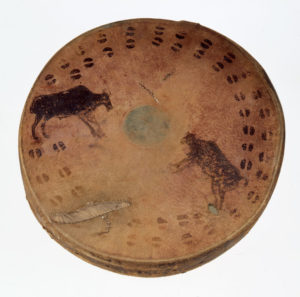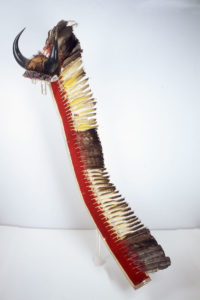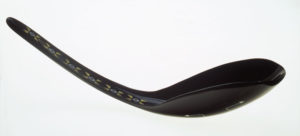What Animals Were Important To The Sioux Tribe
All my Relatives, particularly Buffalo
Lakota philosophy considers the world as a unified whole in which everything is interrelated. Animals are considered to exist relatives that share the Earth as partners with humans. The most important of these relatives continues to be the American bison, popularly known equally the buffalo, with whom Plains people have maintained a special relationship. Ernie Robinson, a member of the InterTribal Bison Cooperative, dedicated to restoring buffalo herds on the reservations, says: The story of the buffalo is also the story of the tribe…. They were almost extinct, but now they're coming back strong. They're survivors… Just like usa.
After acquiring horses in sufficient numbers, the Lakota changed their living habits so that they could hunt more than advantageously. They moved permanently onto the Plains from the woodlands of Minnesota, following the roaming buffalo herds from place to identify beyond the great grasslands.
Along with other neighboring equestrian tribes, the Lakota people relied on the buffalo as their primary resource for meat, housing, tools, and clothing. The bison offered themselves to the people. Every part of their torso was useful, says Sidney Keith, Cheyenne River Sioux. These animals provided nearly all the things that the Lakota needed. Over 100 different uses, in addition to nutrient, have been recorded for the various buffalo parts – parts such equally horns, hide, hair, bones, hooves, tummy, and even dung. Just the buffalo was much more than than a "grocery store." Information technology was a life-giver in the fullest sense. When the Creator made the buffalo, he put a power in them. When you eat the meat, that ability goes into you, heals the trunk and the spirit, explains Les Ducheneaux, Cheyenne River Sioux.
The Groovy Plains teemed with millions of buffalo at the beginning of the 1800s. By 1883, because of overhunting, non one buffalo remained in Lakota territory. The disappearance of the buffalo, the beast that was central to the Lakota's economic and religious life, devastated them. Read below for a timeline of the loss of the buffalo from the Great Plains.
Today, Plains people manage growing herds. Nigh tribes are members of the Inter-Tribal Bison Cooperative, which seeks to preserve and increase tribal herds.
Disappearance of the Buffalo
1700
Buffalo originally ranged across almost of Due north America, numbering betwixt 30 and 100 one thousand thousand animals. In a flow of less than two hundred years, however, a variety of forces combined to decimate the once overwhelming herds.
1800
With the exception of a few small isolated groups, the buffalo'south range was west of the Mississippi River.
1870
In 1867, the get-go railroad permanently divided the buffalo into a northern and southern herd.
1875
Professional buffalo hunters entered the Plains later on 1870 and took four,374,000 animals between 1872 and 1874. Iii to four buffalo were killed for each hide that reached the market.
By 1878, buffalo in the southern range were gone except for small, privately owned herds.
1880
V grand white hunters and skinners assaulted the northern herd.
1884
By 1883 the northern herds were decimated, and only small pockets of buffalo were reported in 1884. The concluding sizable herd existed at Yellowstone National Park, and pocket-sized numbers of animals lived on privately owned ranches.
American Bison
The American Bison (Bison bison), or buffalo, numbered near 60 million when the Europeans arrived in the Americas. Probably no other continent has produced a single wild game fauna in such great numbers.
The greatest concentration of buffalo occurred on the vast grasslands of the Plains and prairies, from the Rocky Mountains to the Mississippi River and from Canada to Texas.
Male buffalos boilerplate 5 to vi anxiety from hoof to hump. Females average from iii 1/two to 4 ane/ii anxiety. The buffalo uses its keen sense of smell to detect enemies, beau buffalo, and nutrient. While grazing, they constantly sniff the surface area around them.
Buffalo normally alive communally in groups of 10 to 20; however, temporary aggressions may form during the breeding season. Bulls apply a repertoire of threat postures and movements in establishing dominance. When a buffalo is curious or excited, its tail stands straight up or out. Conflicts rarely evolve into all-out fighting.
Similar all herd animals living in large groups, buffalo must closely coordinate their activities, every bit a whole herd may alter action within a few minutes. The American bison is notorious for its habit of stampeding.
Making a Home
The Lakota people used buffalo hides and wooden club poles to construct their homes, known as tipis. These homes are cone-shaped rounded structures tapered to an open smoke hole at the summit. Approximately 12-sixteen feet in diameter, they were large enough to house a family.
Lakota men and women worked together to construct tipis. Men cut the lodge poles in the Black Hills and hunted the buffalo, bringing them home for women to set for various uses. Subsequently removing the hair and the mankind, women tanned the hides with the brains of the buffalo. In making a tipi, they trimmed eight to 10 buffalo skins, and sewed the hides together with stiff sinew, which are strips of threadlike material from the buffalo'due south backbone.
Plains people followed the buffalo herds. By necessity, their housing needed to be portable. Lakota women could accept tipis autonomously in a matter of minutes when the people moved to another location. The lodge poles and tipi covering, plus their other appurtenances, were strapped to a travois, a conveyance made from two poles with lashings and pulled by a horse.
Source: https://nsew.carnegiemnh.org/lakota-nation-of-the-plains/the-great-plains/
Posted by: freundyouten.blogspot.com





0 Response to "What Animals Were Important To The Sioux Tribe"
Post a Comment